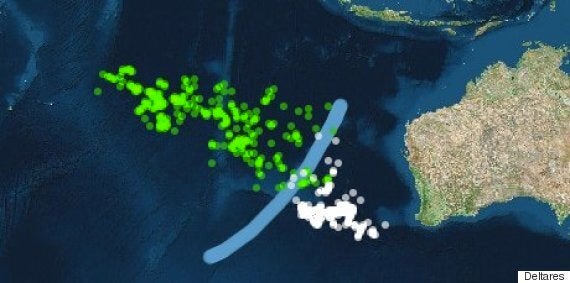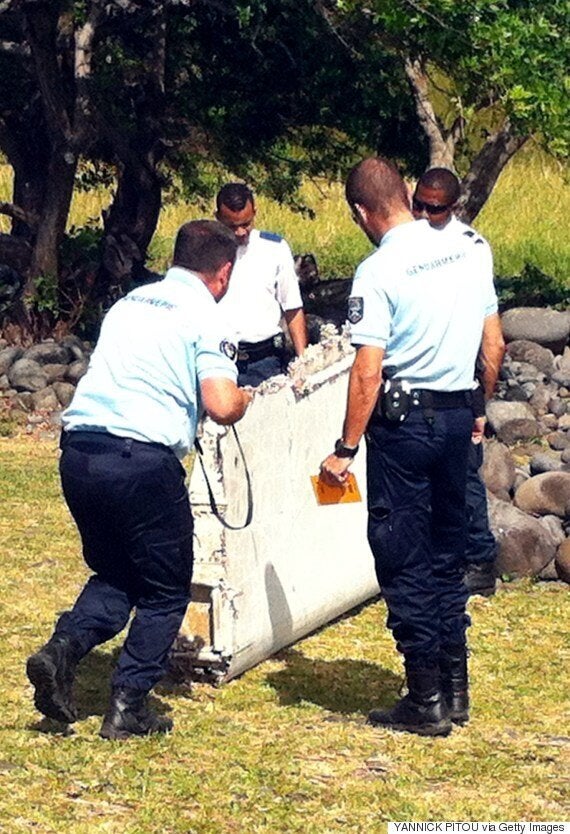Experts have produced a computer simulation which purports to show how suspected MH370 aircraft debris could have travelled from the southwest Australian coast all the way to the shores of Africa.
The clip was created by hydrodynamic specialists at Dutch water research company Deltares and comes amid continuing analysis of plane debris which washed up on Reunion Island in the western Indian Ocean last week.
Deltares expert Maarten van Ormondt said: “The model shows us that the ocean currents are able to carry the debris from the search area west of Australia to Réunion.

The simulation claims to show that the northern part of the search is now a more likely source of debris
“It also suggests that it is more likely that the debris originates from the northern section of the search area than from the southern part.”
The Deltares model was created by Van Ormondt and Fedor Baart using a particle tracking routine to compute the movement of debris from different locations in the search area.
The company explains: “The results show how debris moves with the counter-clockwise gyre in the Southern Indian Ocean and quickly disperses over large areas.
"Particles released in the northern section of the search area arrive at the African coast first within a year of the release time. Those released in the southern section do not travel as far and do not make it to Africa within the simulation period.”
The findings come amid a continued seabed search of the southern Indian Ocean.
Australian Transport Safety Bureau Chief Commissioner Martin Dolan told the Associated Press drift modelling indicated that debris could have floated to the island from where they believed the missing plane crashed 1,800 kilometers (1,100 miles) southwest of Australia.

Officials collect a piece of plane debris on the French island of Reunion
So if the find does prove to be part of the missing aircraft, it would still be consistent with the theory that the plane crashed within the 120,000 square kilometer (46,000 square mile) search area.
"It doesn't rule out our current search area if this were associated with MH370," Dolan said. "It is entirely possible that something could have drifted from our current search area to that island."
"It's unlikely to change the search plans. It would give us confirmation that there is an aircraft definitely in the Indian Ocean," he said.
Dolan said search resources would be better spent continuing the seabed search with sonar and video for wreckage rather than reviving a surface search for debris if the find proved to be from Flight 370.
Confirmation that the wing part was the first trace of Flight 370 ever found would finally disprove theories that the airliner might have disappeared in the northern hemisphere, he added.
The seabed search jointly funded by Australia and Malaysia has so far search 55,000 square kilometers (21,000 square miles) of remote seabed.
The hypothesis is supported supported by oceanographer Dr Simon Boxhall of the University of Southampton.

Oceanographer Dr Simon Boxhall
Last week he told the BBC: “It fits in perfectly. If the plane did indeed go down off the south west coast of Australia then the Western Australian currents will have taken the wing north, it would have then caught up with what we call the southern equatorial current.
“A fast-flowing current would have pushed it towards Madagascar and it would take about 15 to 18 months for any sort of debris at the surface to appear somewhere like Reunion.
“Reunion is a very small island, very remote, but it sort of sits slap bang in the middle of this fast flow."
When asked if he believed further plane parts would be found, he replied: “We would expect it, we were almost waiting for debris to start appearing. The route the debris would have taken goes across a very unpopulated part of the ocean and Reunion is really the first sort of island that these things hit.
"Much of it will appear along the coast of Madagascar, if there is much debris left and then of course it carries on round in a big gyre a big sort of anti-clockwise roundabout and it could spend the next 100 years going around in that gyre. So we would expect to start seeing parts of debris in this area.”
Robin Beaman, a marine geologist at Australia's James Cook University, said there is precedence for large objects travelling vast distances across the Indian Ocean. Last year, a man lost his boat off the Western Australia coast after it overturned in rough seas. Eight months later, the boat turned up off the French island of Mayotte, west of Madagascar - 7,400 kilometers (4,600 miles) from where it disappeared.
"I don't think we should rule anything out, that's for sure," Beaman said.